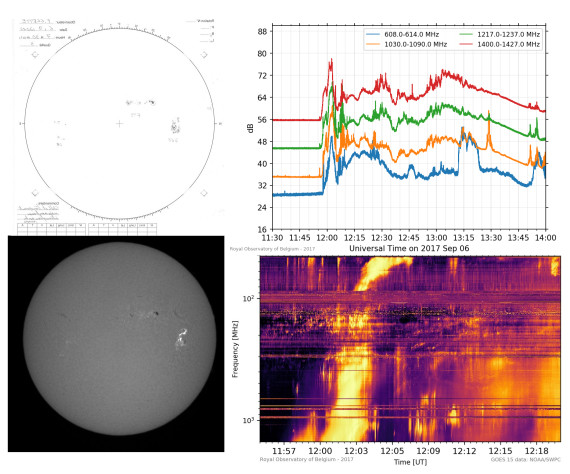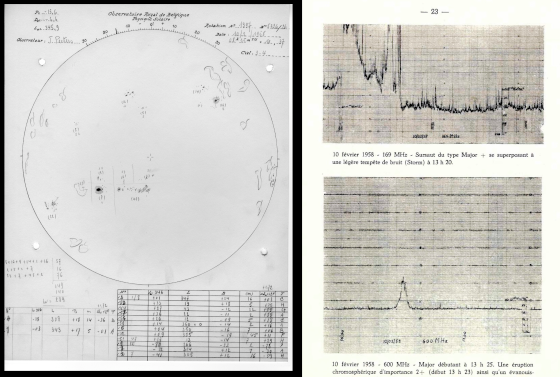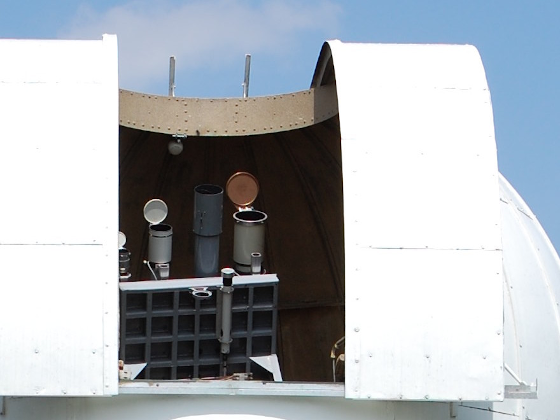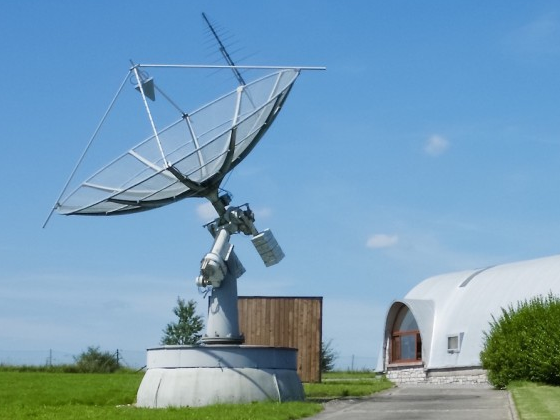
with a strong radio bursts and an H-alpha flare.
The SIDC maintains and develops since the middle of the 20th century an experience in the monitoring of the solar activity from ground based instrumentation, optical (USET) and radio (Humain). The objectives of USET are the production, archival, distribution and exploitation of global information about structures and events in the photosphere and chromosphere, as part of the continuous world-wide ground-based monitoring of solar activity. On the other hand, the solar radio experiments of the Humain radioastronomy station monitor the level of solar activity in the corona, as illustrated by the non thermal radio emissions linked to solar eruptive events such as flares or Coronal Mass Ejections.

Joint USET and Humain observations on February 10, 1958.
Strong radio bursts occur in the sunspot group
near the center of the drawing
Historical facts
It is in 1939 that the Uccle Solar Equatorial Table (USET) station first started its solar observing program, consisting of daily sunspot drawings and solar photography. The current equatorial table was installed in 1953. The prime instruments were the H-alpha telescope, the white-light heliograph, and the old visual 16 cm refractor for sunspot drawings. At the same time, folllowing the advent of electronics and receiving equipment during World War II, radio astronomy was developing world-wide. In Belgium, the Humain radioastronomy station was founded in 1953 with the purchase of farm land close to the village of Humain, near Marche-en-Famenne. Regular observations started in 1954 with a 7.5 m Würzburg radar given by the Belgian army to the Observatory and turned into a solar radio telescope observing at 600 MHz. A 6-m dish parabola started soon after daily solar flux measurements at 169 MHz. In 1957, the construction of the 48 parabola solar interferometer started. The asymmetric T-shape instrument (640 m in EW, 320 m in NS) was a Belgian industrial project involving the Bell Telephone company in Antwerp for the electronics, and the Etablissements Gardier, in Liège for the telescopes.
In the mid-1970, the original optical patrol program was finally abandoned due to the high costs and the very demanding manual processing of photographic images. The observing program then concentrated on synoptic sunspot observations for about 20 years, in the framework of the Sunspot Index Data Center (IAU World Data Center for sunspots, hosted in Brussels since 1981). In radio, the last observations with the interferometer and the Würzburg took place respectively in 2001 and in 2005.
At the beginning of the 2000s, ground-based instruments started to be refurbished. In the visible-light spectrum, new telescopes and imaging systems were progressively installed. Also a new set of solar radio experiments has been gradually put in place since 2008, in the frame of the STCE. Dynamic spectra observations are now performed every day for scientific purposes and to support the space weather forecast center of the Observatory.

Optical Telescopes in Uccle
Current activities
Ground-based observations are taken on a daily basis in radio, and if weather permits in optical wavelengths (260 observation days/year), providing long-term records of the solar magnetic activity. Such observations are needed in solar physics (long-term evolution of the solar cycle, solar irradiance) and in applied science (space weather forecast). Some of the instruments are part of world-wide networks of solar ground-based observations.
In visible light, a small team of observers run the observations. The solar patrol comprises several refractors mounted on an equatorial table:
- The historical 16 cm Grubb refracting telescope continuously used since 1940.
- White-light refractor (broadband filter)
- H-alpha and CaII-K refractors (narrow-band filters centred in 656.3 nm and 393.37 nm, respectively)
- The heritage refractor to make sunspot drawings, providing information on the solar activity on a long-term scale of more than 80 years
The three modern telescopes are equipped with digital cameras recording full-disk images at a base synoptic cadence of 15 minutes, and at a high cadence of 10 seconds in case of transient events. All the data is accessible within 15 min on the USET website. In addition, USET is one of the reference stations for the determination of the International Sunspot Number produced by SILSO. As a world data center, the SILSO's activities consist in managing a worldwide network of more than 80 professional and amateur observers, collect and process their observations. The center maintains the archive of the sunspot index, which spans over more than 3 centuries. In addition, it issues monthly mid-term predictions for the evolution of solar activity. These data can be found on the SILSO website.
In radio, with the support of the STCE, new observations have started in 2008.
A 6-m parabolic telescope supports three spectrometers observing the Sun between 45 and 1500 MHz.
- A Callisto receiver monitors the band 45 - 450 MHz. It is plugged to a log periodic antenna installed on the side of the dish. It is part of the world wide e-Callisto network
- A Software Defined Radio receiver, ARCAS, with a higher sensitivity and a better frequency resolution is installed in parallel to Callisto and share the same antenna and pre-receiving electronics
- A Software Defined Radio receiver, HSRS, is plugged to a small high frequency log periodic antenna, installed at the focus of the 6-m dish. It monitors the band 275 - 1500 MHz
The telescope tracks the Sun automatically from 07:30 till 16:00 UT on a daily basis. Observations are accessible via the Humain website.

Perspective for the future
The ground based observations of the department have been operated along a large period of time. To make this happen, both projects needs to keep in touch with the technical evolution and assure a maintenance of historical instrumentation.
The modernisation of the USET instrumentation is still in progress with the dome control automation, and the telescope off-pointing based on micro-metric translation stage to determine routinely the telescope flat-field maps.
One of the main drawbacks of ground-based observation are gaps in the data series due to the day-and-night cycles as well as bad weather and seeing conditions. One way to overcome this drawback is to merge data taken from different observatories well distributed in geographic longitude to provide continuous data series. In the context of the solarnet/spring project, dedicated image processing method to select the best images and to homogenise the data series are currently developed, as well as method to compensate the poor seeing. In this context, new high-cadence camera are being integrated to the actual step-up, in order to select the brief moments of atmospheric stability. The USET images are used in the DeepSun project. It aims at gaining a better insight of the long-term solar activity by making connections between the long-term sunspot drawings archive, and photospheric and chromospheric images with deep learning methods. The USET images are also the base material of a PhD project, co-supervised with the university of Liège, on the study of the long-term evolution of large-scale magnetic structures on the images.
On the radio side, the increasing use of the radio spectrum and progress in electronics require a constant adaptation of observing strategies to maintain and expand the monitoring capabilities of the solar radio experiments. The SPADE phase array has been recently built in Humain and uses digital technologies to point the instrument and perform low frequency spectral observations of the Sun (20 - 80 MHz). On the other hand, our society relies more and more on technologies which are sensitivity to solar emissions in particular in L band, like radars or GNSS systems. SAFIRE, a flux monitoring system between 1 and 5 GHz is currently being tested, installed on a refurbished 4-m telescope from the old solar interferometer.
Finally raising the awareness of the public towards radio astronomy is a key factor for protecting radio observations. The OART project, aims at refurbishing a 6-m telescope of the station to make it available for the public and educators to discover and teach the basis of radio astronomy. OART and SPADE are funded by Belspo (BRAIN-BE)